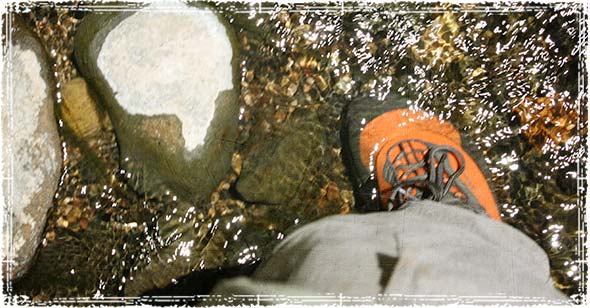Hiking can wreak havoc on your feet; one particularly painful side effect is blisters.

Blisters are probably one of the most common foot related problems that hikers will face while out on the trail. Not only are they painful, but if left on treated they can prevent you from continuing your hike.
What causes Hiking Related Blisters?
The most common reason for getting blisters while out on the trail is wearing the wrong shoe. Friction from an ill-fitting shoe can wreak havoc on your feet and cause painful and debilitating blisters.
When hiking, your foot can move around quite a bit, especially if you are wearing the wrong type of hiking shoe. As you walk, this movement generates friction; which eventually causes your skin to separate, break and blister. But blisters can be prevented, and they will often give you plenty of warning before they appear.
Preventing Painful Blisters While Hiking

Break in Your Boots: Before you set out on a hike, make sure you take the time to break in your boots. Wear them around the office, go to the grocery store, and walk around the house for a few days. This will help stretch and soften the boot.
When taking them out to hike, start slowly with a couple of small hikes. Never set out on a long hike in a new pair of boots.
Pick the Right Size Hiking Boot: The key to preventing blisters is to eliminate friction. This starts by picking the right size boot.
A poor fitting trail shoe is a recipe for disaster, and you need to make sure you really know what you’re buying before you leave the store.
Keep in mind, hiking socks are often thicker than normal socks; so before trying on any new pair of hiking shoes or boots, make sure that you’re wearing the same socks that you’ll be wearing out on the trail.
Lace them up Right: Another reason for blisters is improper lacing.
A boot that is not laced up tight enough can cause your foot to slip around inside the boot, thus increasing friction and the chances of forming a blister.
Air out your Feet: Excessive heat and moisture can add to your foot problems.
Sweaty feet can increase your chances of getting blisters, or even worse, an infection. Make sure you take time to periodically let your feet air out in the open air, and make sure you carry an extra pair of socks to swap out those nasty sweaty ones.
Carry some Duct Tape: The moment you feel a hot spot, is the moment you need to take action. While some people recommend carrying bandages or moleskin, I recommended carrying some Duct Tape in your bag. Believe it or not, Duct Tape can be a great way to prevent blisters from forming.
Think about wearing a Liner Sock: While I’m not a big fan of liners, some people swear by them. If you’ve tried everything, and you’re still having a problem with blisters, you might want to check out something like the Injinji Liner Toesocks. They’re goofy looking, but they can help cut down on skin-on-skin friction — especially between the toes.



MoleSkin!!!!!
sock liners are great because they allow for moisture wicking and they slide against outer socks to reduce the chance of blisters. also they weigh practically nothing and take up no space and can be washed in a river and hung on your pack to dry thus allowing you to have new clean socks every morning no matter how long you go hiking
it may sound absurd, but a little trick I used to use in the army was to put panty liners (the feminine hygiene product), behind my heels. This used to prevent me getting blisters on my heels.
Makes sense, since they’re made for absorbing moisture.
Liners, liners, liners if any. Take away frictionand thats the key. Nilone is Good in the way it strong.
Being in good shape can help a lot. You will tend to keep a better stride and walk properly.
Number 6 is a bit tricky. Though airing your feet can be a good idea, your run the risk of your feet swelling as soon as you take your boots of. Might make it more difficult to put them back on.